Using Remote Sensing Data to Parameterize Ice Jam Modeling for a Northern Inland Delta
Abstract
:1. Introduction
2. Study Site and Methods
2.1. Study Site
2.2. Methods
2.2.1. RIVICE Model
2.2.2. Remote Sensing Dataset
2.2.3. Ice Volume Calculation by Using MODIS
2.2.4. Data Preparation for Model
3. Results
3.1. Ice Volume
3.2. Model Calibration
3.3. Ice Jam Flooding
3.4. Local Sensitivity Analysis
4. Discussion
Author Contributions
Conflicts of Interest
References
- Beltaos, S. Hydrodynamic and climatic drivers of ice breakup in the lower Mackenzie River. Cold Reg. Sci. Technol. 2013, 95, 39–52. [Google Scholar] [CrossRef]
- Helland, I.P.; Finstad, A.G.; Forseth, T.; Hesthagen, T.; Ugedal, O. Ice-cover effects on competitive interactions between two fish species. J. Anim. Ecol. 2011, 80, 539–547. [Google Scholar] [CrossRef] [PubMed]
- Beltaos, S. Comparing the impacts of regulation and climate on ice-jam flooding of the Peace-Athabasca Delta. Cold Reg. Sci. Technol. 2014, 108, 49–58. [Google Scholar] [CrossRef]
- Prowse, T.D.; Conly, F.M. Effects of climatic variability and flow regulation on ice-jam flooding of a northern delta. Hydrol. Process. 1998, 12, 1589–1610. [Google Scholar] [CrossRef]
- Public Works and Government Services of Canada. Slave River—Water and Suspended Sediment Quality in the Transboundary Reach of the Slave River, Northwest Territories; Report Summary; Aboriginal Affairs and Northern Development Canada: Slave River, AB, Canada, 2012.
- Beltaos, S.; Prowse, T.D.; Carter, T. Ice regime of the lower Peace River and ice-jam flooding of the Peace-Athabasca Delta. Hydrol. Process. 2006, 20, 4009–4029. [Google Scholar] [CrossRef]
- Lindenschmidt, K.E.; Sydor, M.; Carson, R.W.; Harrison, R. Ice jam modelling of the Lower Red River. J. Water Resour. Prot. 2012, 4, 16739. [Google Scholar] [CrossRef]
- Lindenschmidt, K.E.; Das, A.; Rokaya, P.; Chu, T.A. Ice-jam flood risk assessment and mapping. Hydrol. Process. 2016, 30, 3754–3769. [Google Scholar] [CrossRef]
- Chu, T.; Das, A.; Lindenschmidt, K.E. Monitoring the variation in ice-cover characteristics of the Slave River, Canada using RADARSAT-2 data—A case study. Remote Sens. 2015, 7, 13664–13691. [Google Scholar] [CrossRef]
- Government RADARSAT Data Services. A New Satellite, A New Vision; Canadian Spave Agency: Sanit-Hubert, QC, Canada, 2010.
- Lindenschmidt, K.-E.; Syrenne, G.; Harrison, R. Measuring Ice Thicknesses along the Red River in Canada Using RADARSAT-2 Satellite Imagery. J. Water Resour. Prot. 2010, 2, 923–933. [Google Scholar] [CrossRef]
- Chu, T.; Lindenschmidt, K.E. Integration of space-borne and air-borne data in monitoring river ice processes in the Slave River, Canada. Remote Sens. Environ. 2016, 181, 65–81. [Google Scholar] [CrossRef]
- Das, A.; Sagin, J.; Van der Sanden, J.; Evans, E.; McKay, K.; Lindenschmidt, K.E. Monitoring the freeze-up and ice cover progression of the Slave River. Can. J. Civ. Eng. 2015, 42, 609–621. [Google Scholar] [CrossRef]
- Vermote, E.F.; Kotchenowa, S.Y.; Bay, J.P. MODIS Surface Reflectance User’s Guide; NASA: Greenbelt, MD, USA, 2015; p. 35.
- Chaouch, N.; Temimi, M.; Romanov, P.; Cabrera, R.; McKillop, G.; Khanbilvardi, R. An automated algorithm for river ice monitoring over the Susquehanna River using the MODIS data. Hydrol. Process. 2014, 28, 62–73. [Google Scholar] [CrossRef]
- Kraatz, S.; Khanbilvardi, R.; Romanov, P. River ice monitoring with MODIS: Application over Lower Susquehanna River. Cold Reg. Sci. Technol. 2016, 131, 116–128. [Google Scholar] [CrossRef]
- Muhammad, P.; Duguay, C.; Kang, K.K. Monitoring ice break-up on the Mackenzie River using MODIS data. Cryosphere 2016, 10, 569–584. [Google Scholar] [CrossRef]
- Shi, L.; Wang, H.; Zhang, W.; Shao, Q.; Yang, F.; Ma, Z.; Wang, Y. Spatial response patterns of subtropical forests to a heavy ice storm: A case study in Poyang Lake Basin, southern China. Nat. Hazards 2013, 69, 2179–2196. [Google Scholar] [CrossRef]
- Maskey, S.; Uhlenbrook, S.; Ojha, S. An analysis of snow cover changes in the Himalayan region using MODIS snow products and in-situ temperature data. Clim. Chang. 2011, 108, 391–400. [Google Scholar] [CrossRef]
- Geldsetzer, T.; van der Sanden, J.; Brisco, B. Monitoring lake ice during spring melt using RADARSAT-2 SAR. Can. J. Remote Sens. 2010, 36, S391–S400. [Google Scholar] [CrossRef]
- Brock, B.E.; Wolfe, B.B.; Edwards, T.W.D. Spatial and temporal perspectives on spring break-up flooding in the Slave River Delta, NWT. Hydrol. Process. 2008, 22, 4058–4072. [Google Scholar] [CrossRef]
- Lindenschmidt, K.-E.; Das, A. A geospatial model to determine patterns of ice cover breakup along the Slave River1. Can. J. Civ. Eng. 2015, 42, 675–685. [Google Scholar] [CrossRef]
- Environment Canada RIVICE Steering Committee. RIVICE Model-User’s Manual; Environment Canada: Winnipeg, MB, Canada, 2013. [Google Scholar]
- Environment Canada, Historical Hydrometric Data. Available online: https://wateroffice.ec.gc.ca/mainmenu/historical_data_index_e.html (accessed on 25 April 2017).
- Lindenschmidt, K.E.; Rode, M. Linking hydrology to erosion modelling in a river basin decision support and management system. In Integrated Water Resources Management; 2001; pp. 243–248. Available online: http://iahs.info/uploads/dms/iahs_272_243.pdf (accessed on 27 April 2017).
- Canada Center for Remote Sensing. Fundamentals of Remote Sensing; CCRS: Ottawa, ON, Canada, 2009. [Google Scholar]
- NASA Level-1 and Atmosphere Archive & Distribution System (LAADS) Distributed Active Archive Center (DAAC), MOD09GQ. Available online: https://ladsweb.nascom.nasa.gov/ (accessed on 27 April 2017).
- ArcGIS Desktop; Version:10.3.1.4959; Environmental Systems Research Institute (ESRI): Redlands, CA, USA, 2015.
- Su, H.; Wang, Y.P. Using MODIS data to estimate sea ice thickness in the Bohai Sea (China) in the 2009–2010 winter. J. Geophys. Res. Oceans 2012, 117, C10018. [Google Scholar] [CrossRef]
- Carstensen, D. Eis im Wasserbau—Theorie, Erscheinungen, Bemessungsgrößen; Selbstverl: Dresden, Germany, 2008. [Google Scholar]
- Vermote, E.; Nixon, D. MOD09 (Surface Reflectance) User’s Guide; NASA: Greenbelt, MD, USA, 2011.
- Khorram, S. Remote Sensing; Springer: Berkeley, CA, USA, 2012; p. 134. [Google Scholar]
- Roerink, G.J.; Menenti, M.; Verhoef, W. Reconstructing cloudfree NDVI composites using Fourier analysis of time series. Int. J. Remote Sens. 2000, 21, 1911–1917. [Google Scholar] [CrossRef]
- Brunner, G.W.; United States Army Corps of Engineers; Institute for Water Resources (U.S.); Hydrologic Engineering Center (U.S.). HEC-RAS River Analysis System-Hydraulic Reference Manual; US Army Corps of Engineers, Institute for Water Resources, Hydrologic Engineering Center: Davis, CA, USA, 2016. [Google Scholar]
- Lindenschmidt, K.E.; Sydor, M.; Carson, R.W. Modelling ice cover formation of a lake-river system with exceptionally high flows (Lake St. Martin and Dauphin River, Manitoba). Cold Reg. Sci. Technol. 2012, 82, 36–48. [Google Scholar] [CrossRef]
- Pietroniro, A.; Leconte, R.; Toth, B.; Peters, D.L.; Kouwen, N.; Conly, F.M.; Prowse, T. Modelling climate change impacts in the Peace and Athabasca catchment and delta: III—Integrated model assessment. Hydrol. Process. 2006, 20, 4231–4245. [Google Scholar] [CrossRef]
- Li, Z.; Huang, G.H.; Wang, X.Q.; Han, J.C.; Fan, Y.R. Impacts of future climate change on river discharge based on hydrological inference: A case study of the Grand River Watershed in Ontario, Canada. Sci. Total Environ. 2016, 548, 198–210. [Google Scholar] [CrossRef] [PubMed]
- Tao, B.; Tian, H.Q.; Ren, W.; Yang, J.; Yang, Q.C.; He, R.Y.; Cai, W.J.; Lohrenz, S. Increasing Mississippi river discharge throughout the 21st century influenced by changes in climate, land use, and atmospheric CO2. Geophys. Res. Lett. 2014, 41, 4978–4986. [Google Scholar] [CrossRef]
- Lindenschmidt, K.E.; Chun, K.P. Evaluating the impact of fluvial geomorphology on river ice cover formation based on a global sensitivity analysis of a river ice model. Can. J. Civ. Eng. 2013, 40, 623–632. [Google Scholar] [CrossRef]
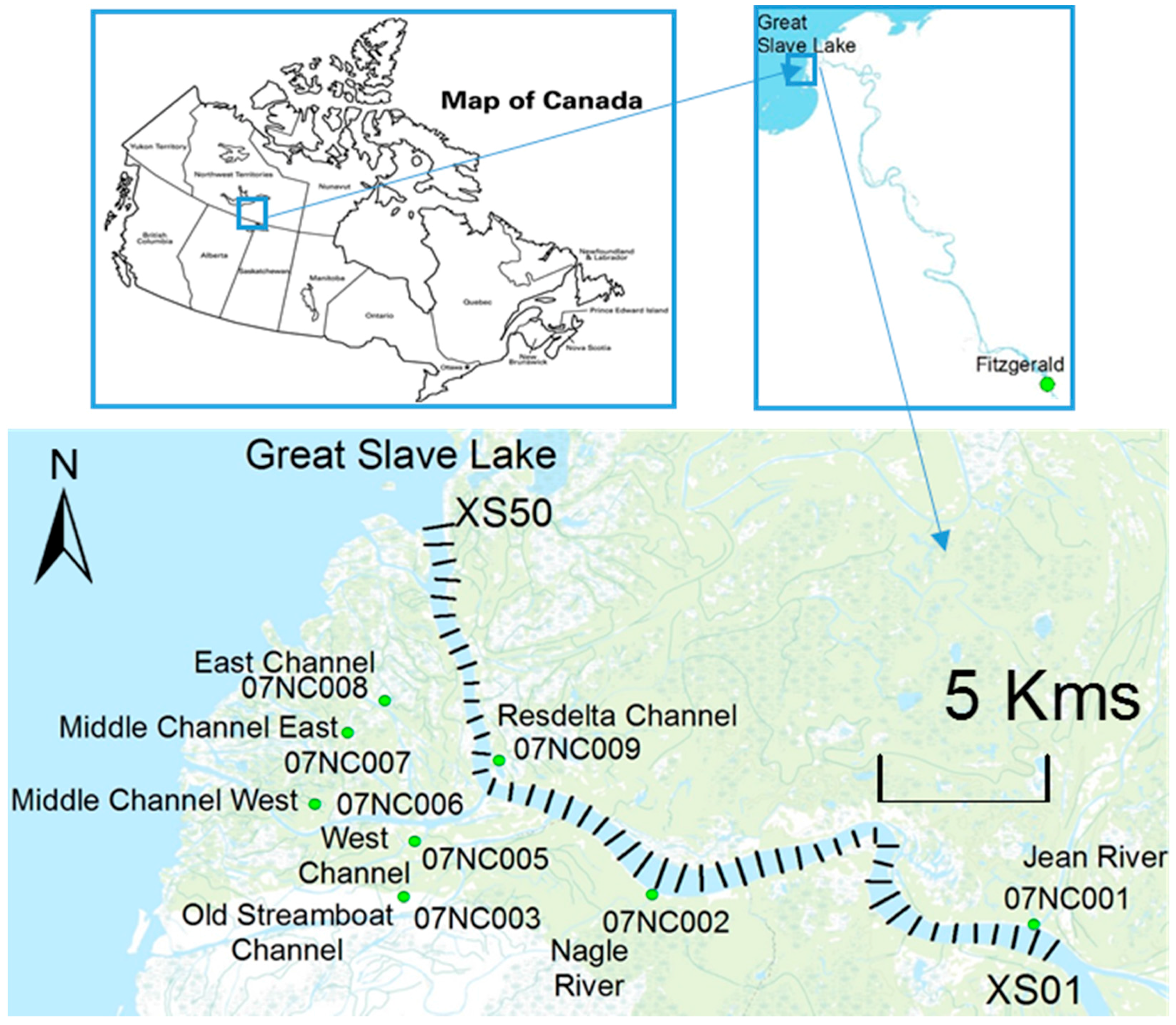
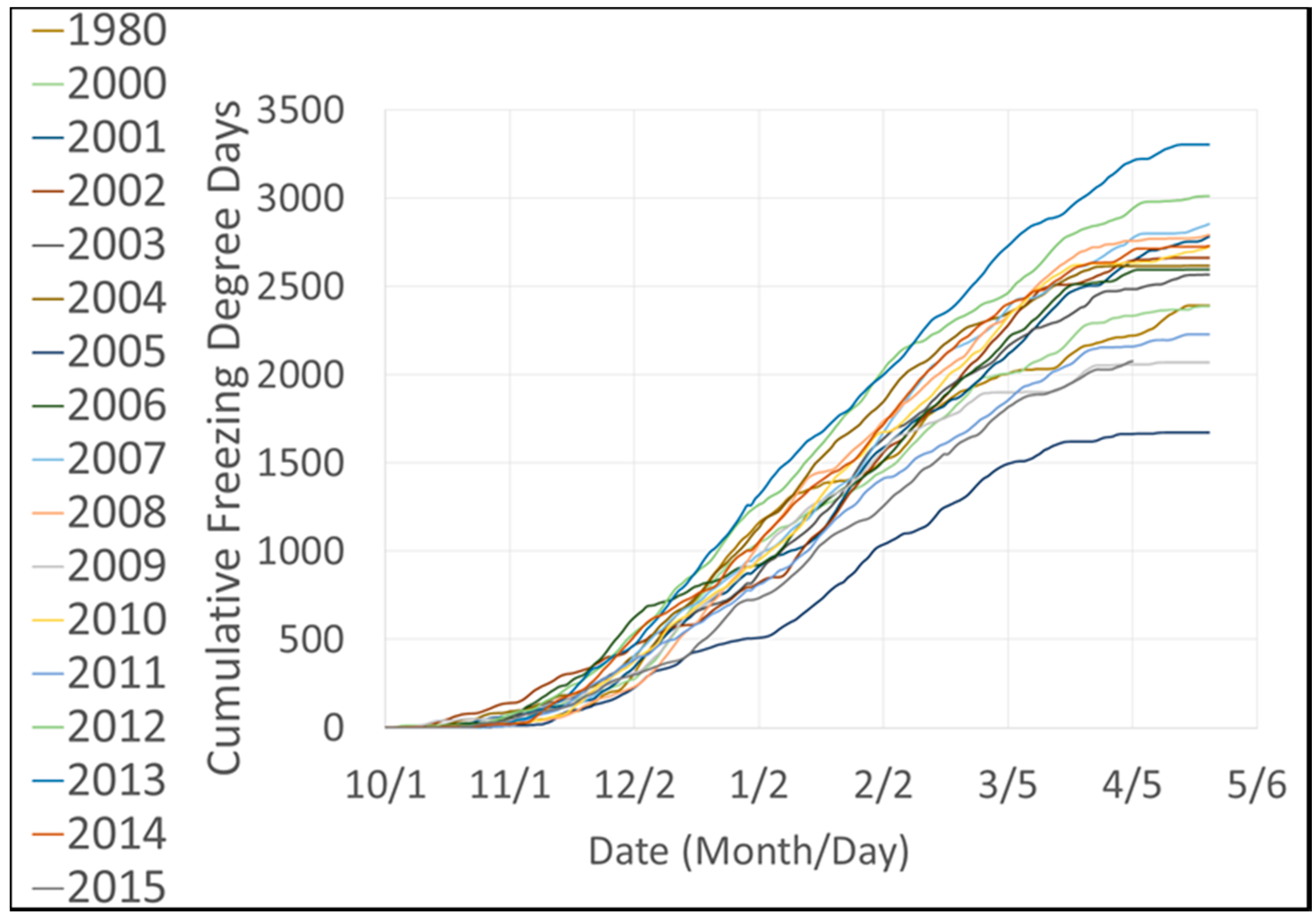
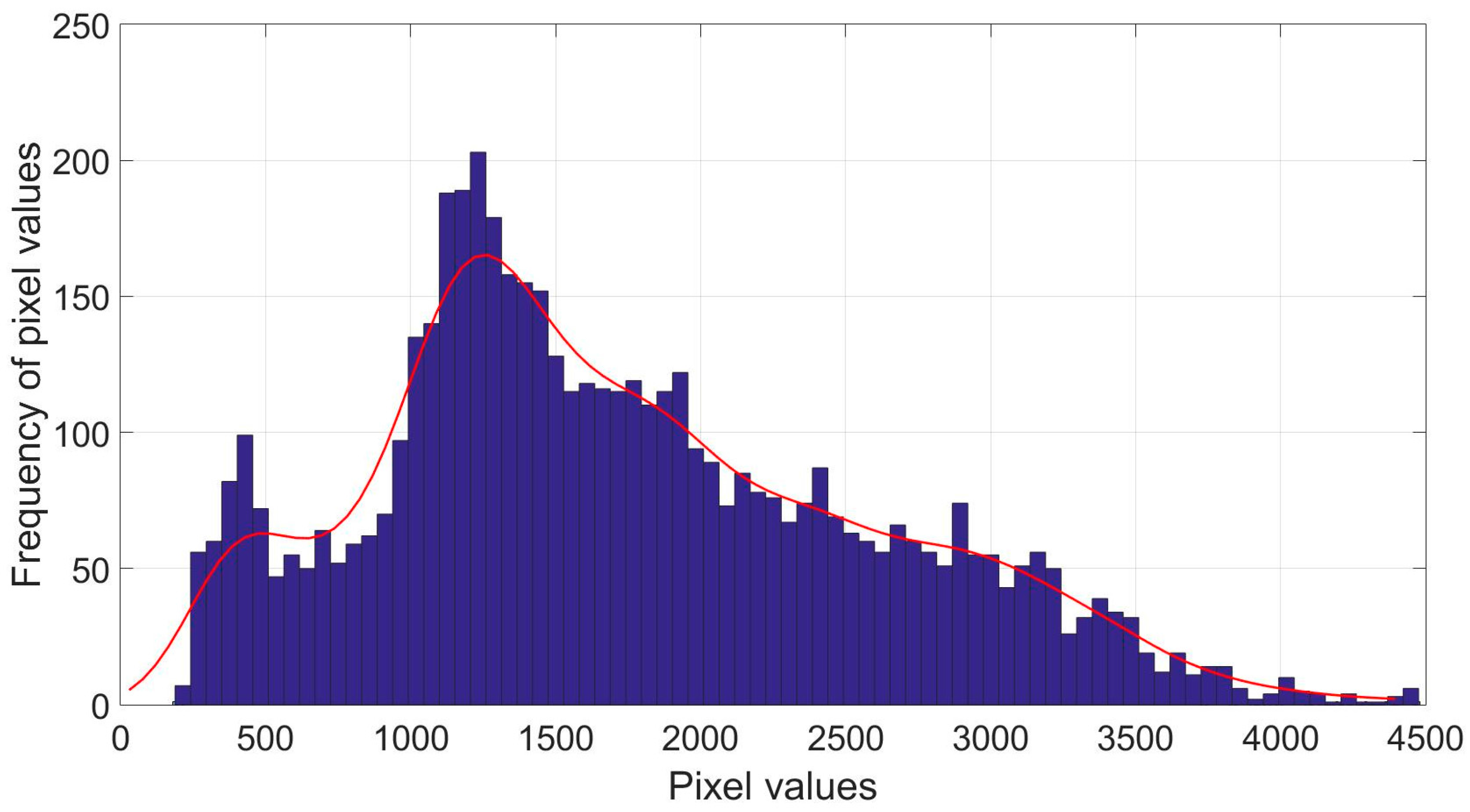
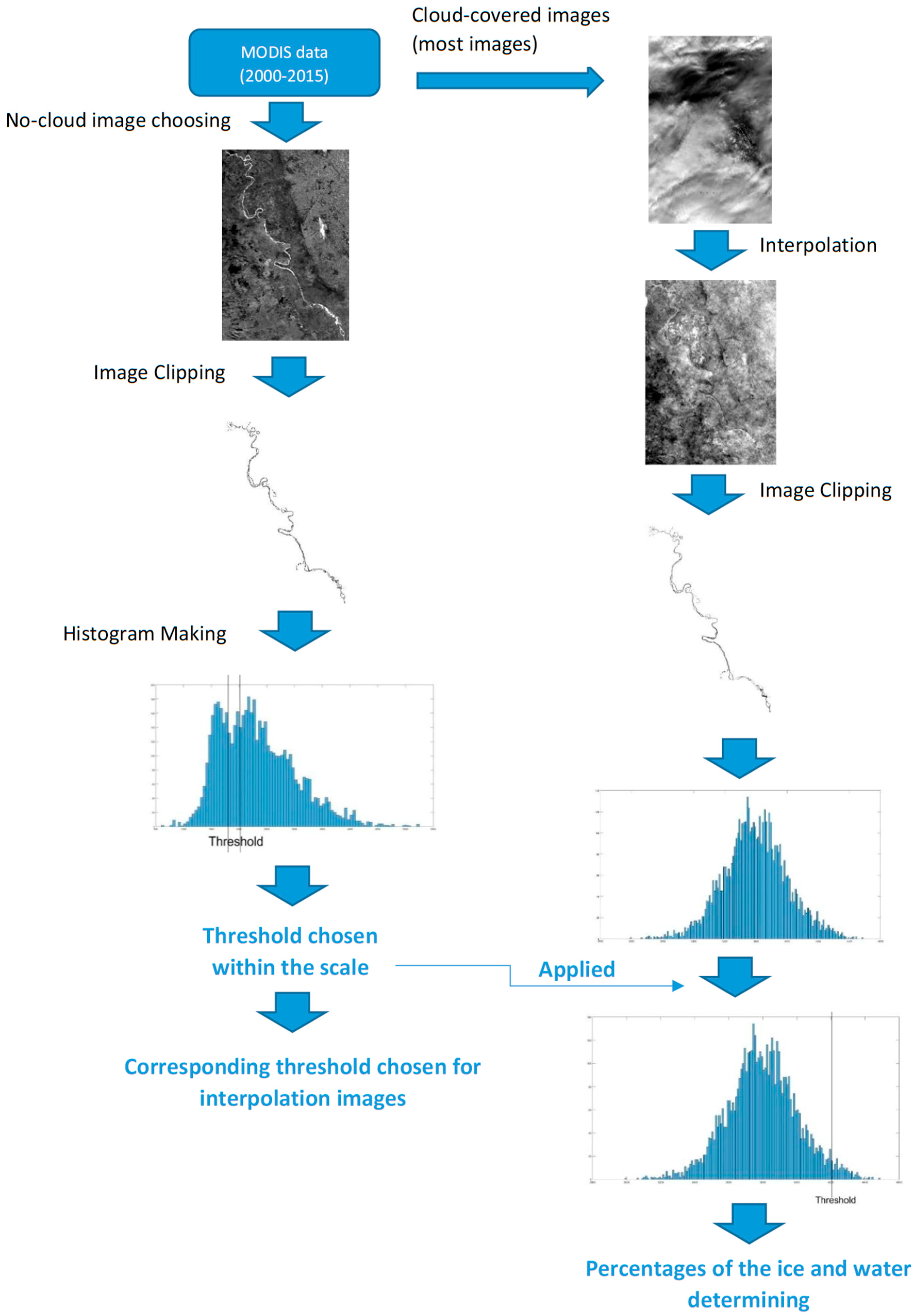
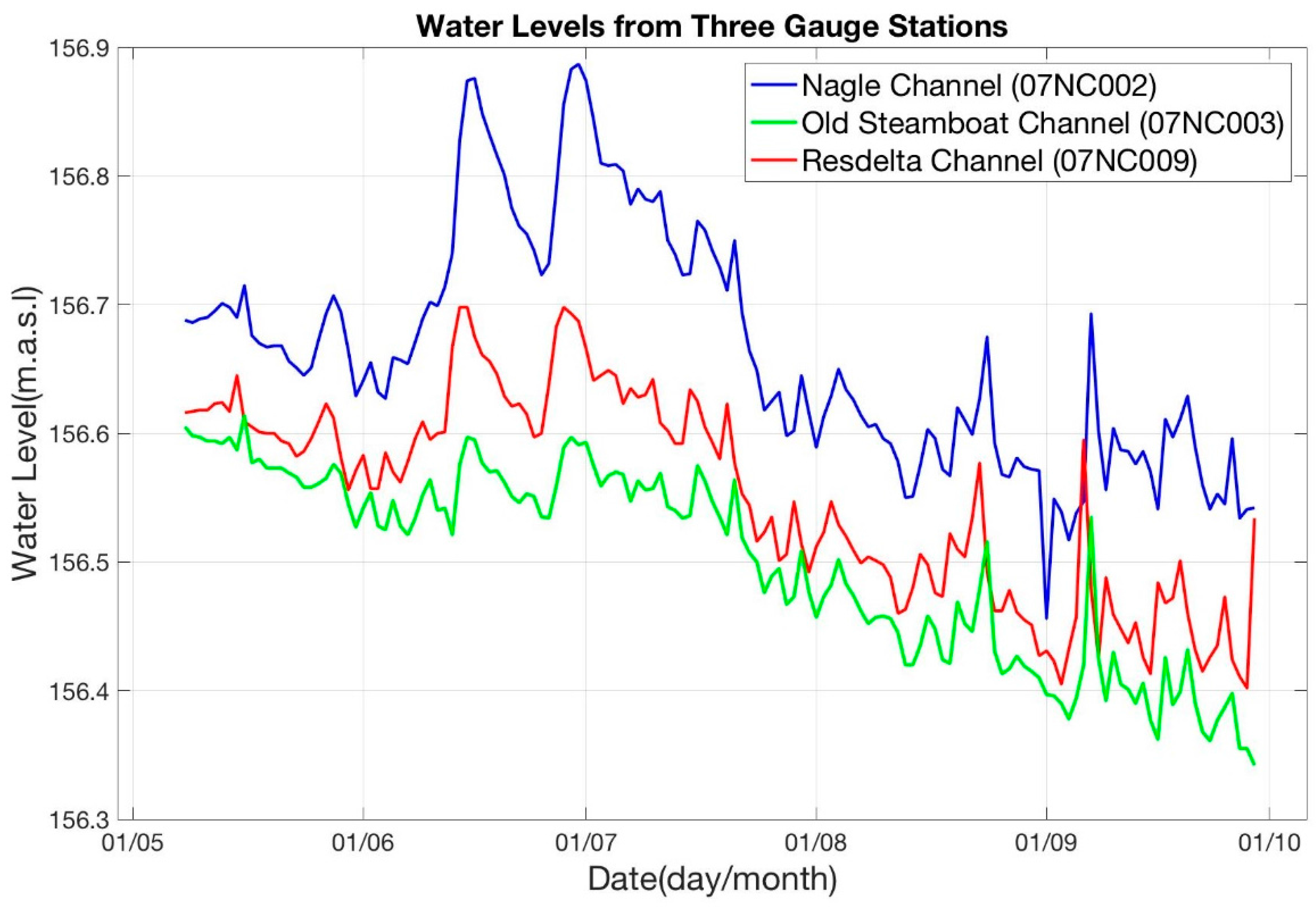

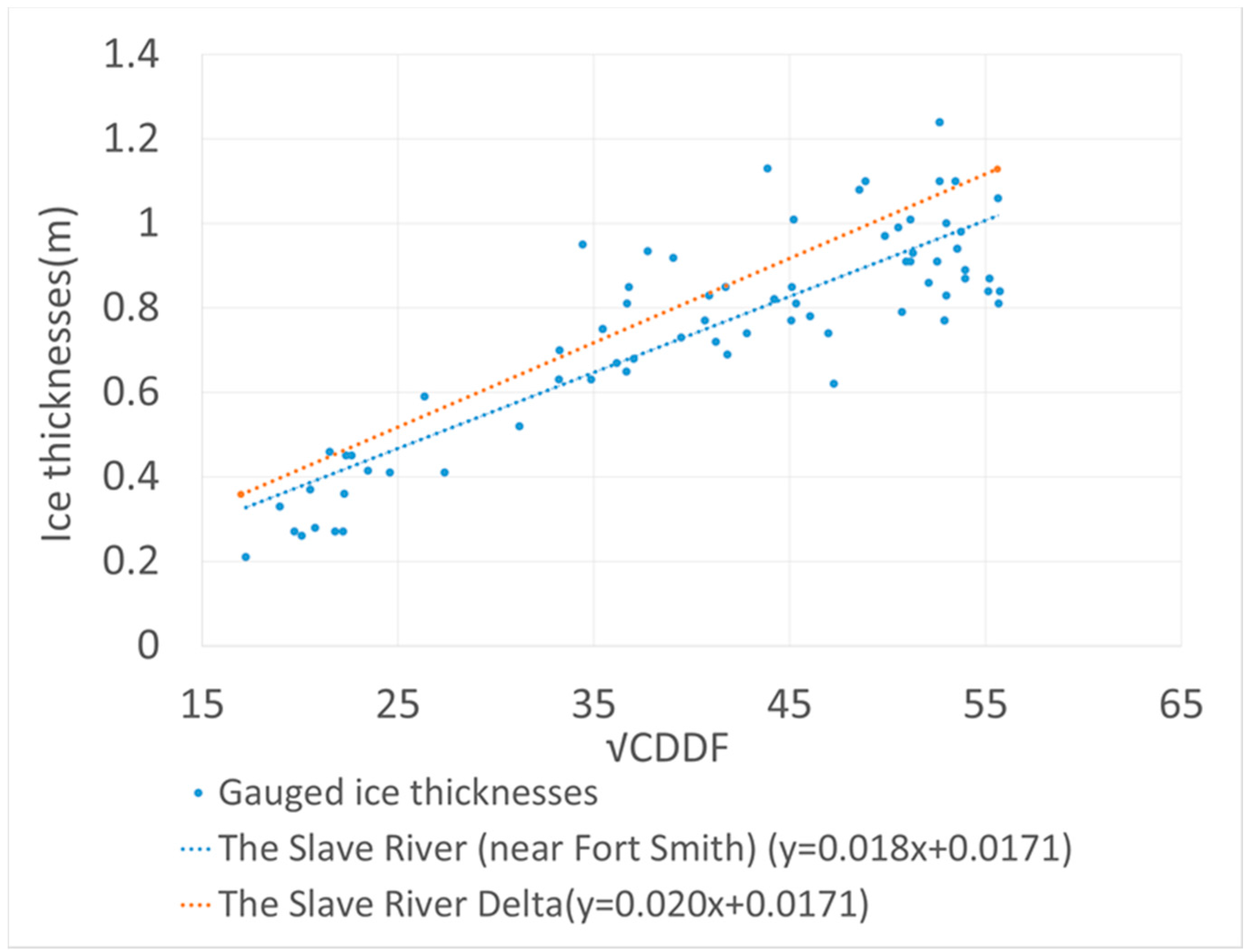
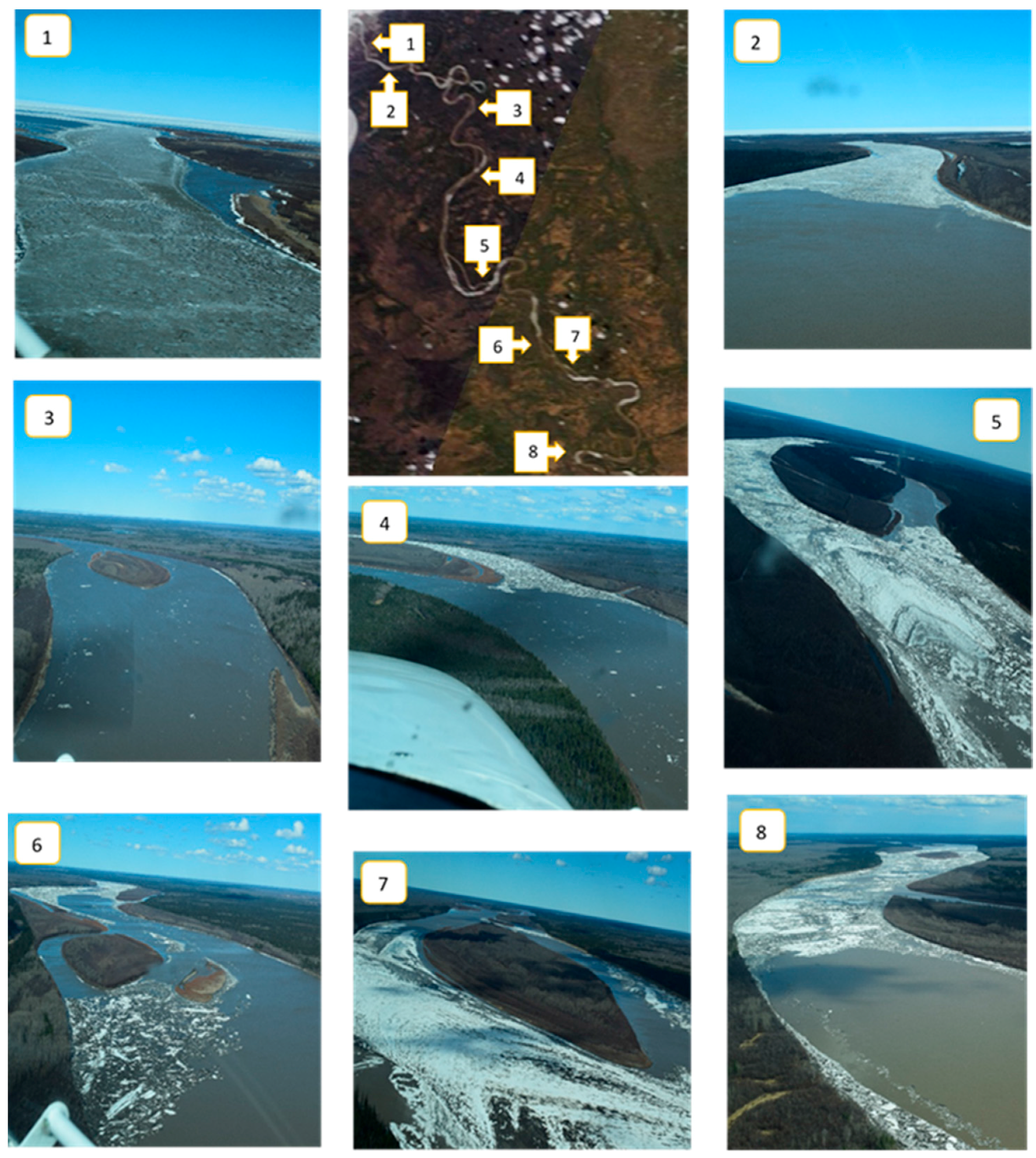
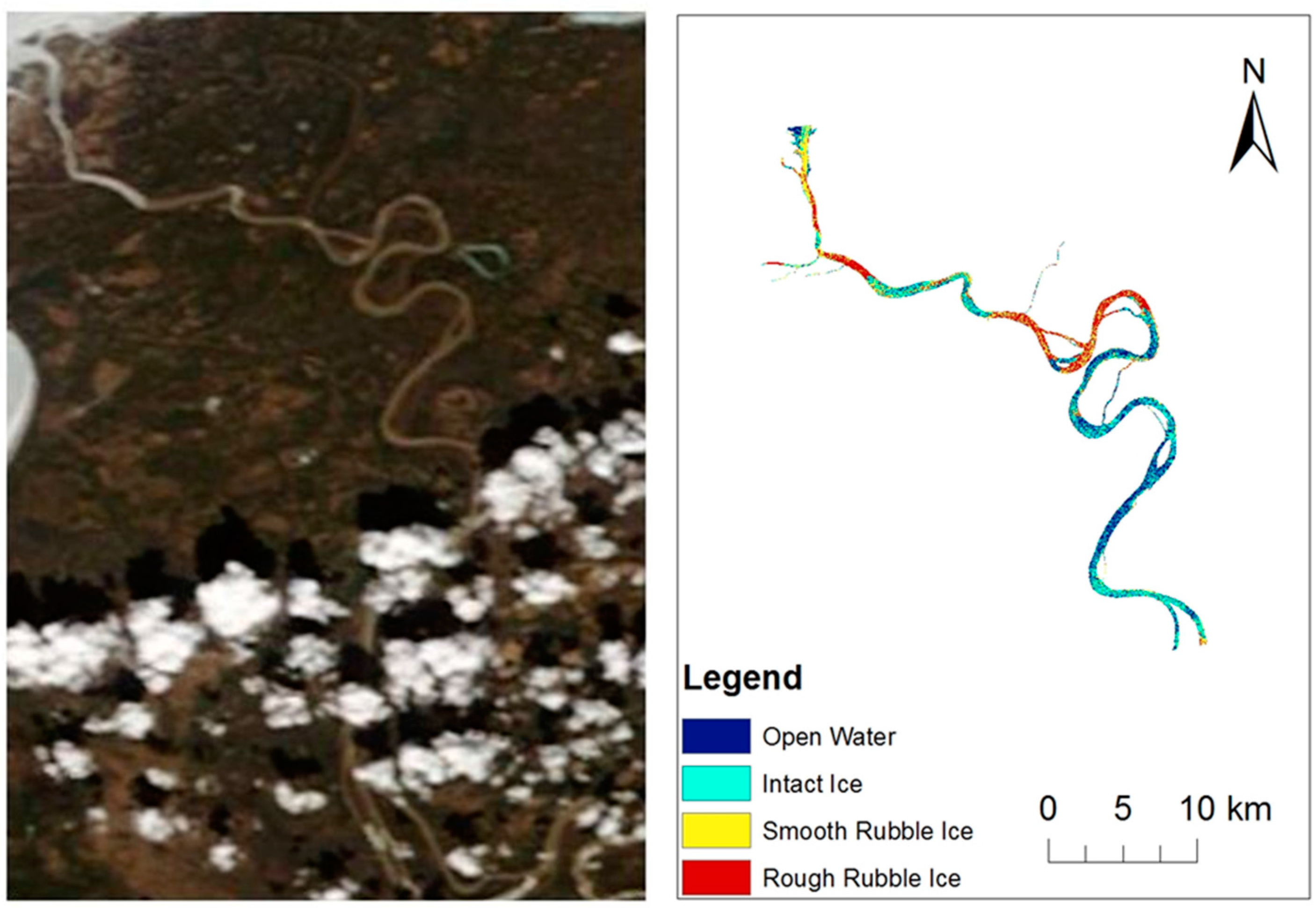
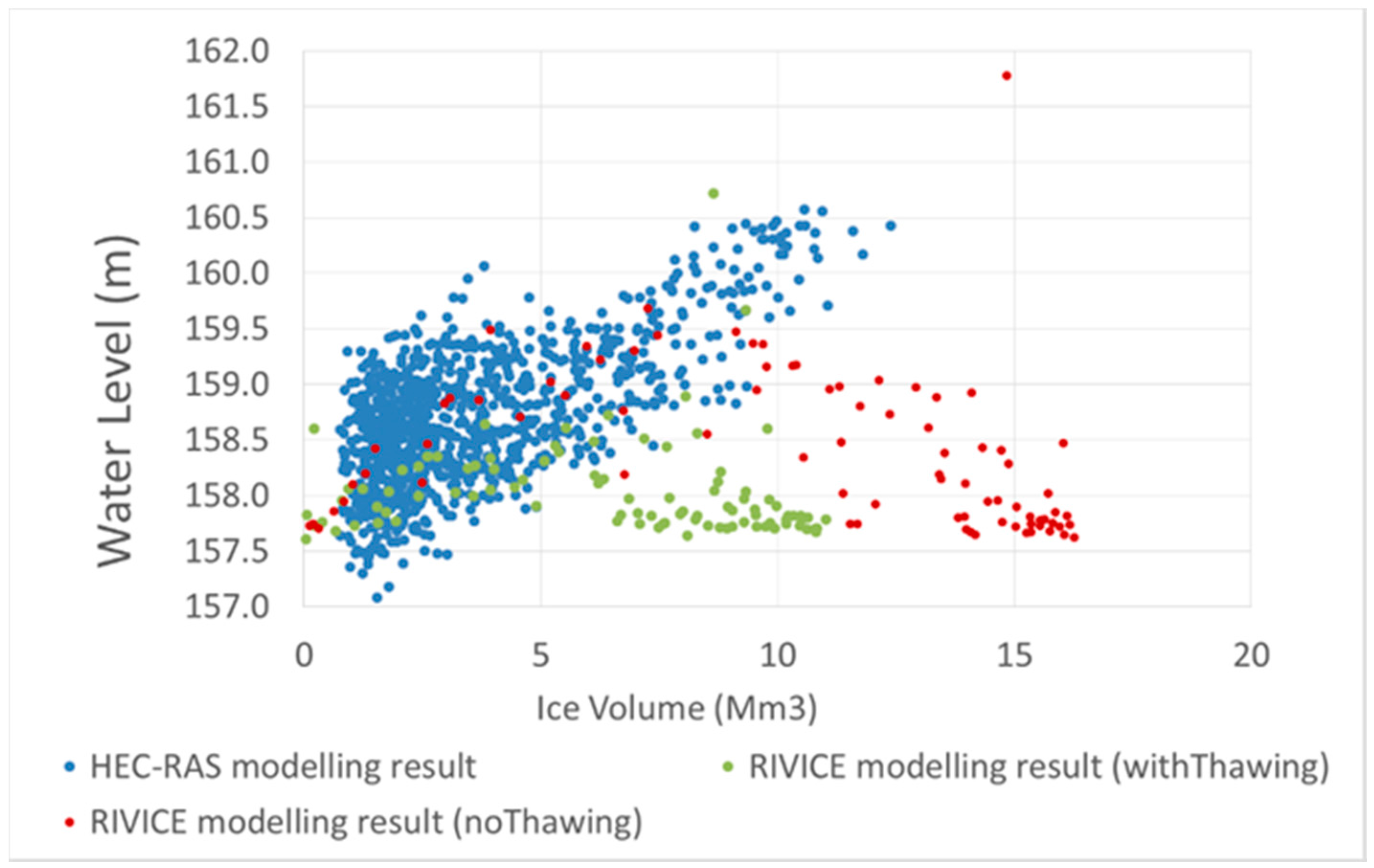

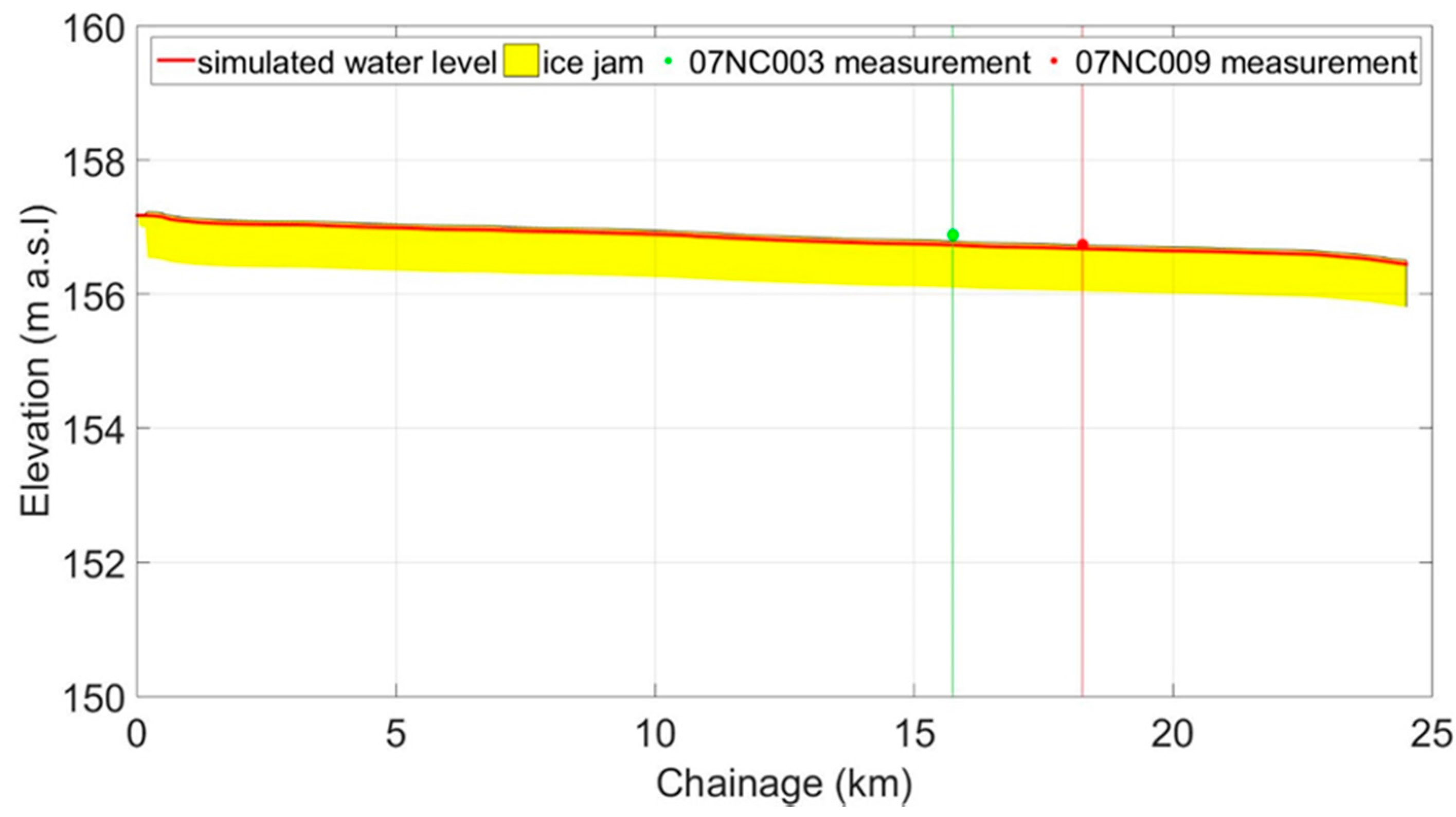
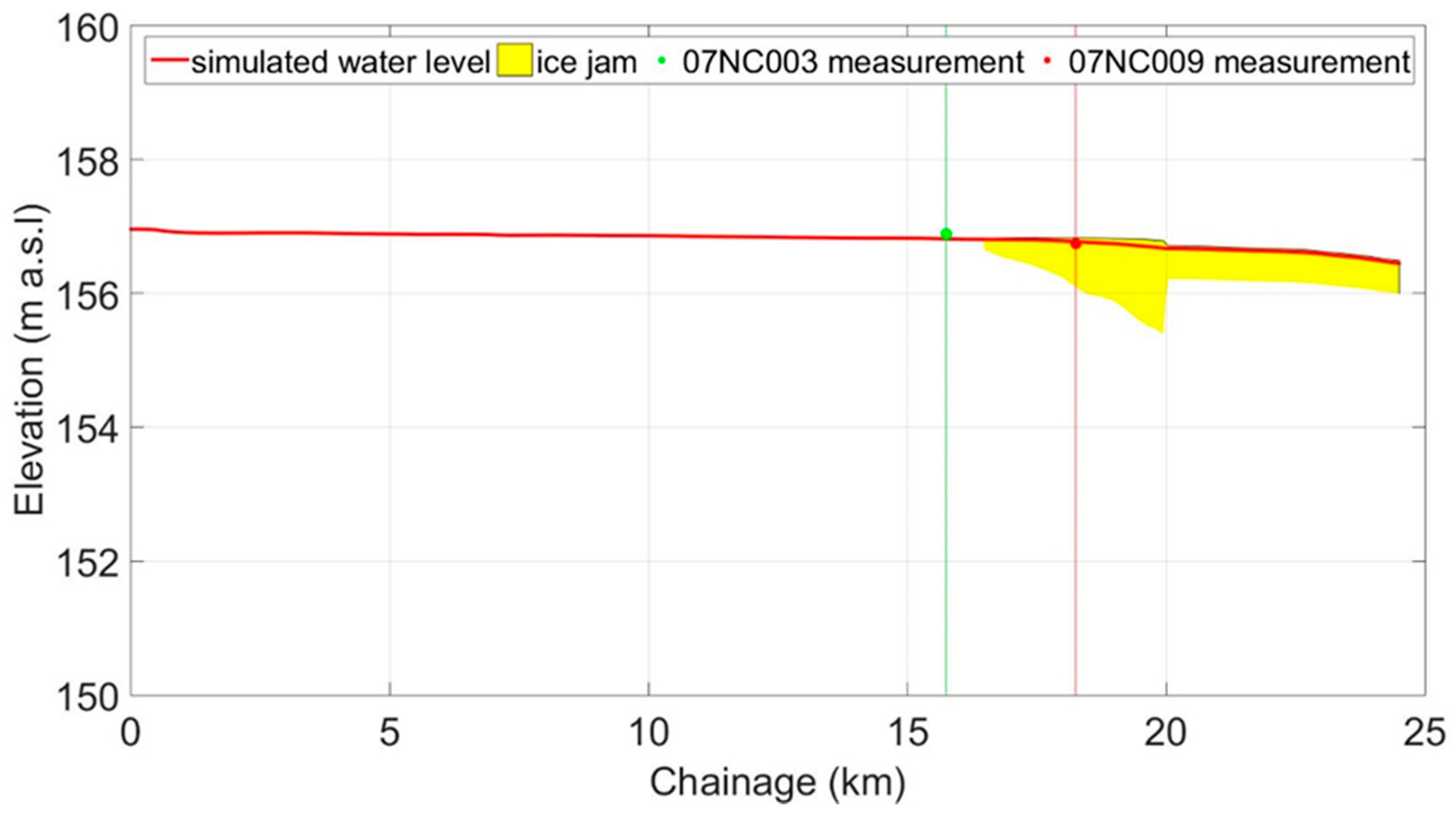

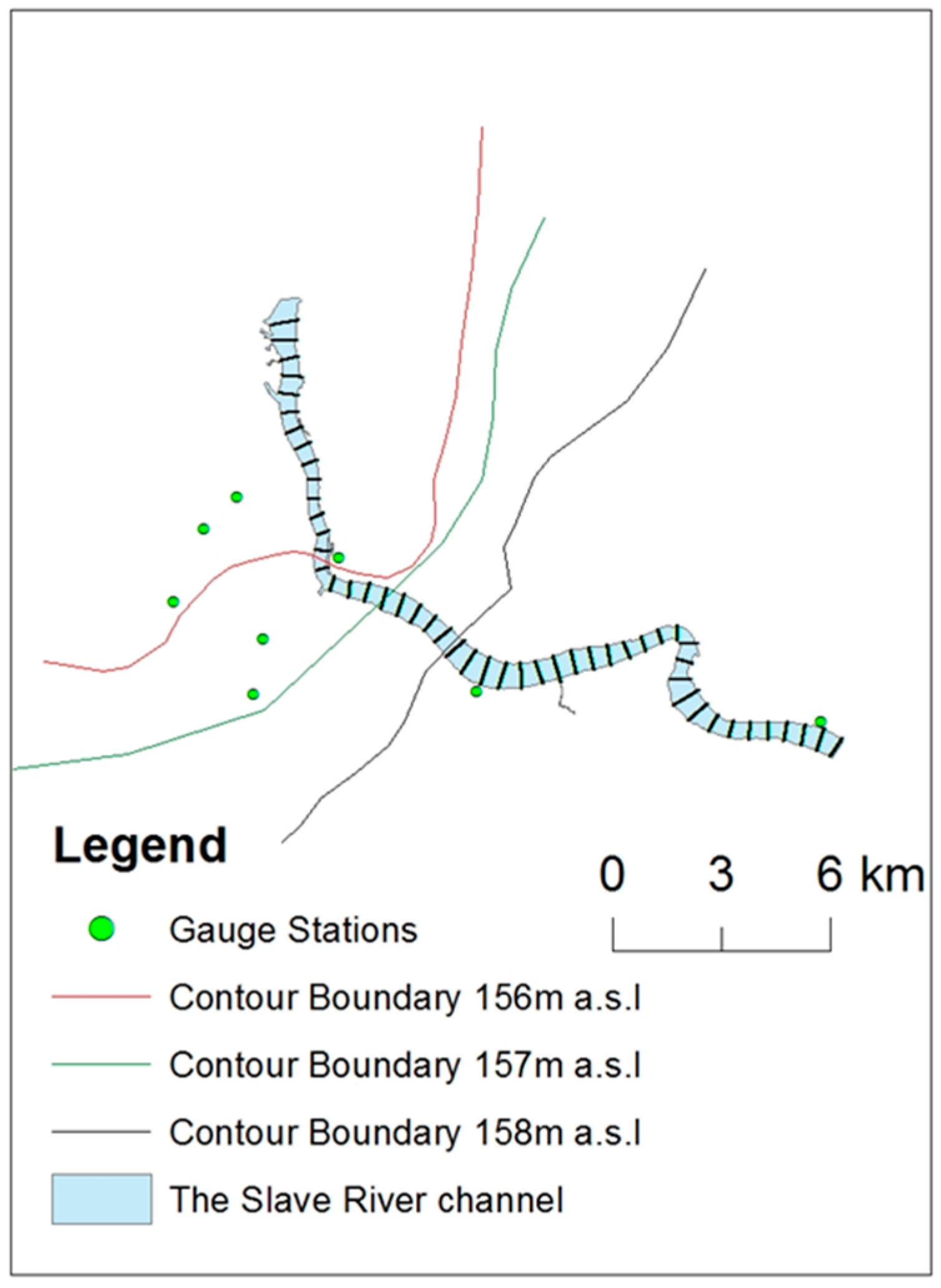
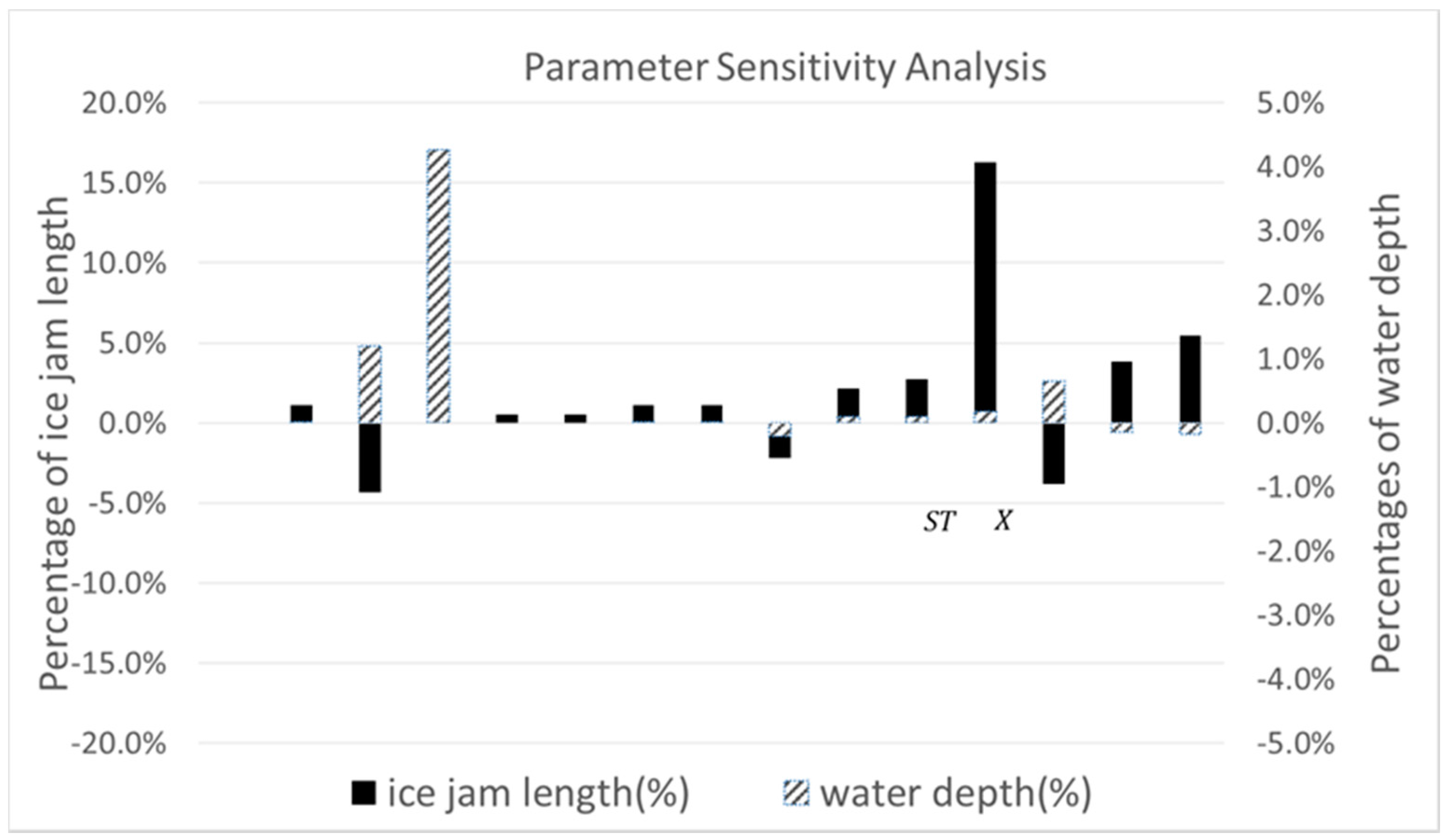
| Parameters | Description | Units |
|---|---|---|
| Hydraulic roughness | ||
| River bed roughness | s/m1/3 | |
| Ice roughness | s/m1/3 | |
| Boundary conditions | ||
| Q | Upstream discharge | m3/s |
| W | Downstream water level | m a.s.l. 1 |
| Ice cover characteristics | ||
| Ice deposit velocity | m/s | |
| Ice erosion velocity | m/s | |
| Inflowing ice volume | m3 | |
| FT | Thickness of ice cover front | m |
| PC | Porosity of ice cover | — |
| X | Ice bridge location (from XS1 in Figure 1) | m |
| Strength properties | ||
| K1TAN | Lateral: longitudinal stresses | — |
| K2 | Longitudinal: vertical stresses | — |
| Slush ice characteristics | ||
| PS | Porosity of slush | — |
| ST | Thickness of slush pans | m |
© 2017 by the authors. Licensee MDPI, Basel, Switzerland. This article is an open access article distributed under the terms and conditions of the Creative Commons Attribution (CC BY) license (http://creativecommons.org/licenses/by/4.0/).
Share and Cite
Zhang, F.; Mosaffa, M.; Chu, T.; Lindenschmidt, K.-E. Using Remote Sensing Data to Parameterize Ice Jam Modeling for a Northern Inland Delta. Water 2017, 9, 306. https://doi.org/10.3390/w9050306
Zhang F, Mosaffa M, Chu T, Lindenschmidt K-E. Using Remote Sensing Data to Parameterize Ice Jam Modeling for a Northern Inland Delta. Water. 2017; 9(5):306. https://doi.org/10.3390/w9050306
Chicago/Turabian StyleZhang, Fan, Mahtab Mosaffa, Thuan Chu, and Karl-Erich Lindenschmidt. 2017. "Using Remote Sensing Data to Parameterize Ice Jam Modeling for a Northern Inland Delta" Water 9, no. 5: 306. https://doi.org/10.3390/w9050306
APA StyleZhang, F., Mosaffa, M., Chu, T., & Lindenschmidt, K.-E. (2017). Using Remote Sensing Data to Parameterize Ice Jam Modeling for a Northern Inland Delta. Water, 9(5), 306. https://doi.org/10.3390/w9050306







